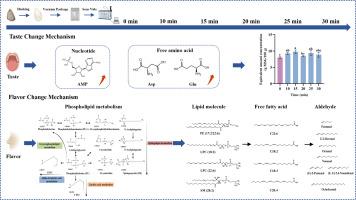当前位置:
X-MOL 学术
›
Food Chem.
›
论文详情
Our official English website, www.x-mol.net, welcomes your
feedback! (Note: you will need to create a separate account there.)
Effect of sous-vide processing duration on flavor and taste variations of oyster (Crassostrea gigas)
Food Chemistry ( IF 8.5 ) Pub Date : 2024-11-15 , DOI: 10.1016/j.foodchem.2024.142066 Hao Zhang, Zhenxiao Hou, Zhe Jia, Kunya Cheng, Zekai Fan, Shi Yuan Dong
Food Chemistry ( IF 8.5 ) Pub Date : 2024-11-15 , DOI: 10.1016/j.foodchem.2024.142066 Hao Zhang, Zhenxiao Hou, Zhe Jia, Kunya Cheng, Zekai Fan, Shi Yuan Dong

|
Sous-vide (SV), as a mild processing technique, exhibits some potential for keeping the original flavor of oyster. The dynamic changes mechanism of flavor and taste in oyster during SV processing (0–30 min/75 °C) were investigated. SV processing for 10–15 min improved the umami of oysters, likely due to the increase in adenosine monophosphate and glutamate, while processing for 20–30 min resulted in a significant loss of “grassy” flavor. GC–MS and GC-IMS analysis showed that the loss of short-chain aldehydes, such as (E)-2-pentenal, (E)-2-hexenal and (E, E)-2,4-hexadienal may be related to the weakening of the “grassy” flavor, and the formation of 2,3-diethylpyrazine and octanal produced a “cooked” and “fatty” flavor. The analysis of lipidomics indicated that phosphatidylethanolamine, lysophosphatidylcholine and sphingomyelin, synthesized mainly through glycerophospholipid and sphingolipid metabolism, were key precursors for aldehyde formation. This study provides a theoretical basis for controlling the flavor quality of oyster during mild processing.
中文翻译:

真空低温烹调加工时间对牡蛎 (Crassostrea gigas) 风味和味道变化的影响
真空低温烹调 (SV) 作为一种温和的加工技术,在保持牡蛎的原始风味方面表现出一定的潜力。研究了 SV 加工过程中 (0–30 min/75 °C) 牡蛎风味和味道的动态变化机制。SV 加工 10-15 分钟改善了牡蛎的鲜味,这可能是由于单磷酸腺苷和谷氨酸的增加,而加工 20-30 分钟导致“青草”风味显着损失。GC-MS 和 GC-IMS 分析表明,(E)-2-戊烯醛、(E)-2-己烯醛和 (E,E)-2,4-己二醛等短链醛的损失可能与“青草味”减弱有关,2,3-二乙基吡嗪和辛醛的形成产生了“煮熟”和“脂肪”的味道。脂质组学分析表明,主要通过甘油磷脂和鞘脂代谢合成的磷脂酰乙醇胺、溶血磷脂酰胆碱和鞘磷脂是醛形成的关键前体。本研究为控制温和加工过程中牡蛎的风味品质提供了理论依据。
更新日期:2024-11-20
中文翻译:

真空低温烹调加工时间对牡蛎 (Crassostrea gigas) 风味和味道变化的影响
真空低温烹调 (SV) 作为一种温和的加工技术,在保持牡蛎的原始风味方面表现出一定的潜力。研究了 SV 加工过程中 (0–30 min/75 °C) 牡蛎风味和味道的动态变化机制。SV 加工 10-15 分钟改善了牡蛎的鲜味,这可能是由于单磷酸腺苷和谷氨酸的增加,而加工 20-30 分钟导致“青草”风味显着损失。GC-MS 和 GC-IMS 分析表明,(E)-2-戊烯醛、(E)-2-己烯醛和 (E,E)-2,4-己二醛等短链醛的损失可能与“青草味”减弱有关,2,3-二乙基吡嗪和辛醛的形成产生了“煮熟”和“脂肪”的味道。脂质组学分析表明,主要通过甘油磷脂和鞘脂代谢合成的磷脂酰乙醇胺、溶血磷脂酰胆碱和鞘磷脂是醛形成的关键前体。本研究为控制温和加工过程中牡蛎的风味品质提供了理论依据。


















































 京公网安备 11010802027423号
京公网安备 11010802027423号